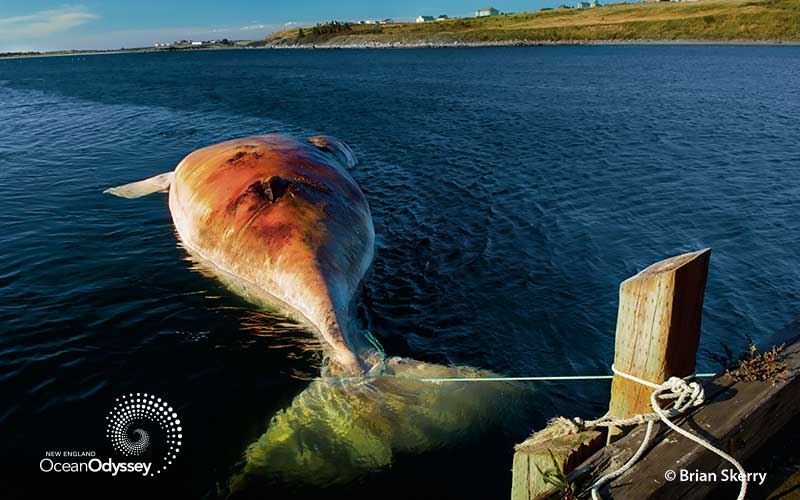
This whale was towed to shore for study after being struck and killed by a boat. Photo: Brian Skerry
North Atlantic right whales can grow bigger than a school bus, weigh up to 70 tons, and have few natural predators. So why is a species near the top of the food chain critically endangered? Well, they’re at risk from a species a notch higher than the right whale: humans.
While it’s been illegal for humans to hunt them for almost half a century, our actions are still taking a deadly toll on right whales. Thick ropes attached to our fishing traps often fatally ensnare these gentle giants. Boats and ships frequently strike them, leaving them with painful and even deadly injuries. Fewer than 350 of these majestic whales now remain, and fewer than 70 are potential new mothers, the only hope for the recovery of this species. Fortunately, we have the ability to create the policies and tools to end the threats to this iconic species – if we act now.
Fishing Gear Kills Endangered Right Whales
Right now, more than a million thick vertical lengths of rope connect gillnets and lobster traps on the seafloor to buoys on the surface. This turns right whales’ migration path through New England and Canada into a dangerous obstacle course. Whales can quickly become entangled in those ropes, with potentially fatal consequences.
Ropes can catch on fins, tails, and mouths, causing a whale to panic. As the whale tries to free itself, its movements can instead cause the rope to wrap around its body, tightening, and sometimes cutting it to the bone. For a calf, it could be fatal if they can’t get to the surface to breathe. Bigger right whales may drag heavy fishing gear for months or even years. The injuries can stunt growth, prevent female right whales from calving, and frequently lead to their deaths. More than 80% of right whales carry scars from entanglements in fishing gear.
With fewer than 350 North Atlantic right whales left on the planet, these majestic creatures can’t afford a single loss. No fisherman wants to harm whales, but shutting down lucrative fishing grounds entirely would hurt the economy of coastal communities. That’s why we’re calling for the funding and adoption of ropeless (or on-demand) gear in specific high-risk areas, which will allow the fishing industry to thrive while protecting vulnerable whales.
Watch to learn how people are fighting to save right whales from entanglements:
Collisions with Ships and Boats Kill Endangered Right Whales
Unfortunately, when right whales go up against fast-moving ships and boats with sturdy hulls and sharp propellers, the whales usually lose. Even smaller boats moving fast enough can cause broken bones, deep cuts, and other potentially lethal injuries. We must urgently enact NOAA’s proposed policies to restrict vessels’ speeds in the right whales’ migration path.
Since 2017, at least 12 right whales are confirmed to have been struck and killed by ships and boats, which is likely an undercount – only about one-third of all whale deaths are documented. Calves are especially vulnerable. For a critically endangered population with fewer than 350 remaining whales, this is a huge threat.
To protect whales from these brutal losses, CLF is calling for NOAA to implement its proposed restrictions on vessels’ speeds when they’re likely to cross paths with right whales. Under the new proposed regulations, vessels over 35 feet would be required to keep to 10 knots when traveling through right whale migration areas. Going 10 knots or less reduces the chances of whale deaths by 80% to 90%.
Current speed restrictions, which only affect ships and boats over 65 feet long in very limited areas, are not enough to protect whales. A few years ago, a 54-foot-long boat struck a right whale named Infinity and her calf. Infinity received likely fatal injuries and her calf was killed, while the boat itself was damaged beyond repair, a $1.2 million loss. Alternatives, like technology that would allow pilots to reliably detect and avoid whales, simply aren’t available yet.
The new proposed regulations are carefully targeted to right whales’ migration patterns to minimize the impact on commercial and recreational use of the water, while keeping both boaters and whales safe.
How Can We Save North Atlantic Right Whales?
Both ropeless fishing gear and stronger speed restrictions could ensure a future for the endangered North Atlantic right whale, fisheries, and boaters. Ropeless gear can prevent whales from painful and fatal entanglements, but only if it’s quickly funded and adopted in key areas at key times.
NOAA’s proposed restrictions on ship and boat speeds are still only proposals. We need strong public support to make them a reality. Right whales will begin their migration in a few short months. We can’t afford another season of avoidable fatalities. Please reach out to your legislator and encourage them to act urgently to end these preventable deaths.
We must act quickly to keep right whales from going from “critically endangered” to “extinct.”



